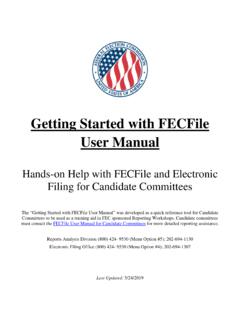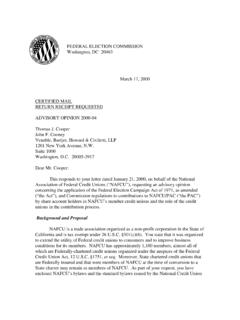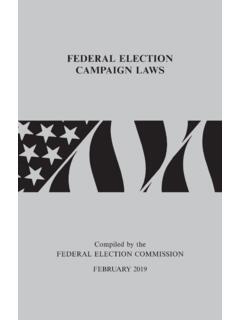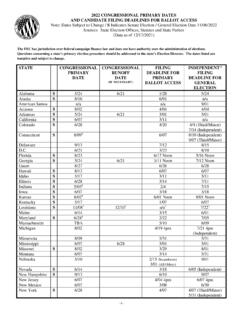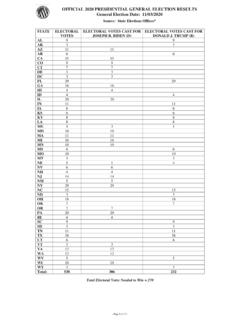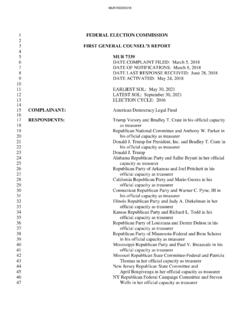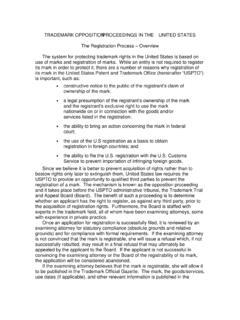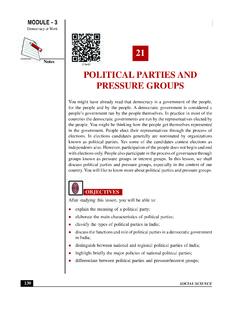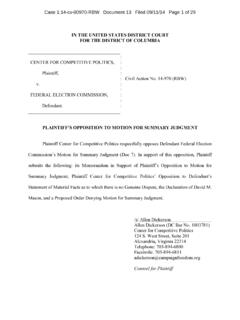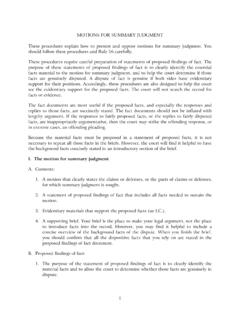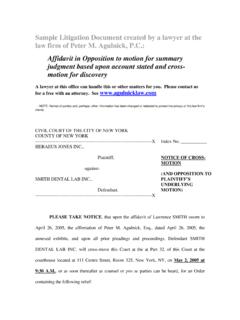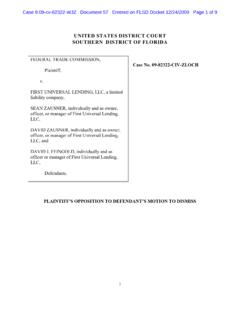Transcription of Plaintiffs’ Opposition to Motion to Dismiss
1 United States District CourtDistrict of ColumbiaShaun McCutcheon et al., Election Commission,DefendantCiv. No. 1:12-cv-01034-JEB-JRB-RLW THREE-JUDGE COURTP laintiffs Opposition to Motion to DismissFEC has filed a Motion to Dismiss ( Motion ) based on Federal Rule of Civil Procedure12(b)(6). (Doc. 21.) Plaintiffs oppose the 12(b)(6) provides that parties may assert by Motion a defense based on failure to statea claim upon which relief can be granted. Fed. R. Civ. P. 12(b)(6).The Rule 12(b)(6) test has been revised in recent years. In Conley v. Gibson, 355 41(1957), the Supreme Court stated the interplay between Rule 8 (pleading) and Rule 12(b)(6) asfollows: [T]he accepted rule [is] that a complaint should not be dismissed for failure to state aclaim unless it appears beyond doubt that the plaintiff can prove no set of facts in support of hisclaim which would entitle him to relief.
2 355 at 45-46. In Bell Atlantic Corporation , 55 544 (2007), the Court noted questions raised regarding the no set of facts test and clarified that once a claim has been stated adequately, it may be supported by showingany set of facts consistent with the allegations in the complaint, id. at 563. It continued: Conley, then, described the breadth of opportunity to prove what an adequate complaint claims,not the minimum standard of adequate pleading to govern a complaint s survival. Id. In AshcroftOpposition to Motion to Dismiss1 Case 1:12-cv-01034-JEB-JRB-RLW Document 23 Filed 09/04/12 Page 1 of 8v. Iqbal, 556 662 (2009), the Court further elaborated on the test, including this statement: To survive a Motion to Dismiss , a complaint must contain sufficient factual matter, accepted astrue, to state a claim to relief that is plausible on its face.
3 Id. at 1949 (citation omitted). Wherea complaint is inadequate, leave to amend the complaint is common. See, , Butt v. UnitedBrotherhood of Carpenters & Joiners of America, No. 09 4285, 2010 WL 2080034 ( 19, 2010).But FEC asserts no factual inadequacy in the Complaint and seeks dismissal with preju-dice after the consolidated Motion hearing. ( Motion 2 (emphasis added).) Rather, it claims that as a matter of law it has demonstrated the constitutionality of the challenged individual bien-nial contribution limits. ( Motion 1.) FEC particularly relies on the notion that Buckley v. Valeo,424 1 (1976), foreclosed Plaintiffs as-applied and facial challenge to the aggregate contri-bution limit.
4 ( Motion 1.).These arguments go to the merits, and Plaintiffs have already addressed the merits at lengthin their Verified Complaint ( VC ) (Doc. 1), Preliminary-Injunction Memo ( PI-Mem. ) ( ), and Preliminary-Injunction Reply ( PI-Reply ) (Doc. 20) all refuting the FEC s claim thatit has demonstrated the constitutionality of the challenged limits and all establishing the uncon-stitutionality of the limits as shown below, (A) Buckley did not foreclose as-applied challenges; (B) Buckley did notrule on the new biennial-contribution-limits statute and its revised statutory context; (C) FEC hasnot proven the constitutionality of the present limits; and (D) this Court has already left openpossible additions to the s Facial Holding Could Not Have Foreclosed As-Applied Challenges.
5 FEC argues that Buckley foreclosed this challenge as a matter of law. This line of attackOpposition to Motion to Dismiss2 Case 1:12-cv-01034-JEB-JRB-RLW Document 23 Filed 09/04/12 Page 2 of 8will sound familiar to anyone familiar with the FEC s strategy in the landmark litigation resultingin the decision in FEC v. Wisconsin Right to Life, 551 449 (2007) ( WRTL-II ). WRTL-II is1designated as a II because there was a I, , Wisconsin Right to Life v. FEC, 546 410(2006) (per curiam) ( WRTL-I ). In Wisconsin Right to Life v. FEC, No. 04-1260, 2004 WL3622736 ( Aug. 17, 2004), a three-judge court denied a preliminary injunction to WRTLand ordered briefing on FEC s argument that the facial upholding of the ban on corporate elec-tioneering communications (2 441b) in McConnell v.
6 FEC, 540 93 (2003), fore-closed as-applied challenges. Then the court held that WRTL s as-applied challenge to BCRAis foreclosed by the Supreme Court s decision in McConnell. Accordingly, WRTL s case is dis-missed with prejudice. WRTL, No. 04-1260, 2005 WL 3470512 ( May 10, 2005).This dismissal was appealed to the Supreme Court. Oral argument was January 17, 2006; adecision issued January 23, 2006. See (Supreme Court docket). The Court vacated the decision below, re-versed, and remanded for the three-judge court to consider the merits of WRTL s as-appliedchallenge in the first instance. WRTL-I, 546 at 412.
7 The Court s holding was simple: Inupholding [the ban on corporate electioneering communications] against a facial challenge, wedid not purport to resolve future as-applied challenges. Id. at remand, the three-judge court considered cross-motions for summary judgment and heldin favor of WRTL. WRTL, 466 F. Supp. 2d 195 ( 2006). Of course, the Supreme Courtaffirmed that three-judge court in WRTL-II, 551 449 which ultimately led to the decisionstriking facially the corporate ban in Citizens United v. FEC, 130 S. Ct. 876 (2010), in principleTwo of Plaintiffs counsel herein (Bopp and Coleson) were counsel for Wisconsin Right to1 Life ( WRTL ) in the cited to Motion to Dismiss3 Case 1:12-cv-01034-JEB-JRB-RLW Document 23 Filed 09/04/12 Page 3 of 8part because the FEC adopted a two-part, 11-factor balancing test to implement WRTL s ruling,id.
8 At 895, creating a scheme that function[ed] as the equivalent of prior restraint, id. at 896,and was precisely what WRTL sought to avoid, id. And regarding the facial versus as-appliedissue, Citizens United noted the following:The controlling opinion in WRTL, which refrained from holding the statute invalid exceptas applied to the facts then before the Court, was a careful attempt to accept the essentialelements of the Court's opinion in McConnell, while vindicating the First Amendmentarguments made by the WRTL parties . 551 , at 482, 127 2652 (opinion of ROB-ERTS, ).Id. at s current effort to persuade this Court that Buckley foreclosed as-applied challenges toa biennial contribution limit even if Buckley were binding as to a facial challenge, which it isnot, see infra simply recycles a rejected litigation tactic doomed to failure Did Not Rule Facially on the Present Limits in the Present claims that Buckley upheld the aggregate contribution limit as a constitutional meansof.
9 Reducing .. corruption. ( Motion 1.) Analytically, FEC still fails to argue with the preci-sion required where First Amendment burdens on core political activity exist because Buckleyrelied on a circumvention interest, not a generic corruption interest. (PI-Mem. 8-10, 13-30).Buckley s facial holding does not control though its analysis guides the analysis (PI-Mem. 8-10) because, inter alia, Congress fixed the problems that Buckley identified (PI-Mem. 10-12),in BCRA, Congress repealed and replaced the old overall ceiling that Buckley considered (PI-Mem. 12), and Buckley did not even mention contributions to candidates as posing a potentialcircumvention problem in its brief discussion facially upholding the old ceiling (PI-Mem.)
10 33-41). Has Not Proven the Constitutionality of the Present part of FEC s claim that as a matter of law it has demonstrated the constitutionality Opposition to Motion to Dismiss4 Case 1:12-cv-01034-JEB-JRB-RLW Document 23 Filed 09/04/12 Page 4 of 8of the challenged individual biennial contribution limits ( Motion 1), it points to various parts ofits Preliminary-Injunction Memorandum that it incorporates by reference ( Motion 1-2). Ofcourse, Plaintiffs may (and do hereby) simply incorporate by reference their Preliminary-Injunc-tion Memo and Reply, which rebut each of FEC s assertions. But in particular, Plaintiffs notethat FEC here still relies on inapplicable soft-money cases ( , McConnell v.
